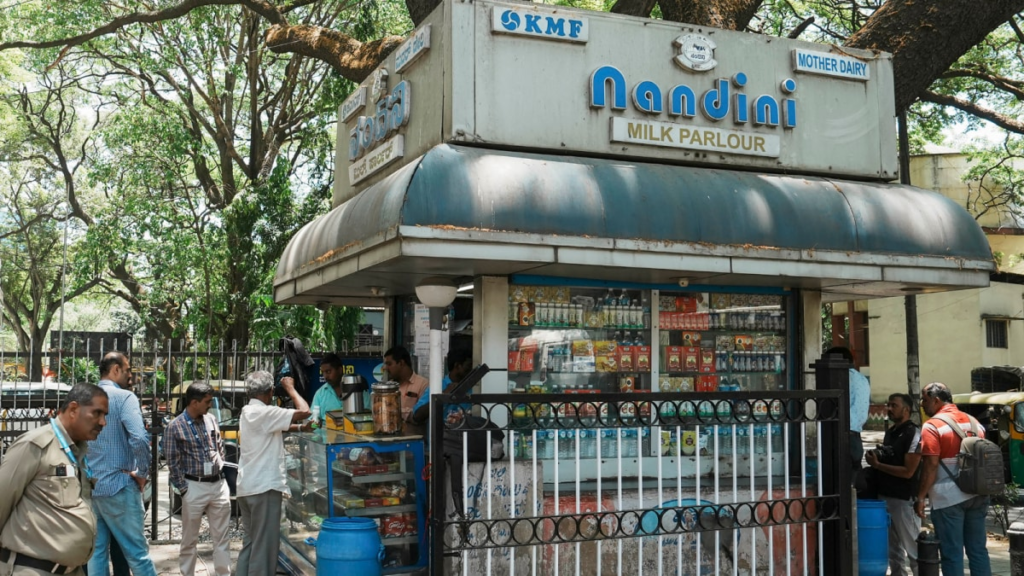
Last Updated:
From April 1, toned milk will cost Rs 46 per litre (up from Rs 42), homogenised milk Rs 47 (up from Rs 43), pasteurised milk Rs Rs 50 (up from Rs 46), and Shubham special milk Rs 54 (up from Rs 48). The price of…Read More

After negotiations, the Karnataka government approved a Rs 4 increase in Nandini milk and curd prices. (Image: PTI)
Tighten your purses as your milk and curd just got dearer with the Karnataka Milk Federation (KMF) hiking the prices of its brand Nandini’s milk and dairy products by Rs 4 — the third increase since the Congress came to power in Karnataka.
Milk farmers in Karnataka had demanded a Rs 10 per litre price hike, arguing that rising costs have made it difficult to sustain their livelihood. But after negotiations, the government approved a Rs 4 increase in Nandini milk and curd prices.
“Farmers had sought at least a Rs 10 hike per litre, but we had to balance consumer interests. Initially, we considered Rs 5, but the cabinet settled on Rs 4,” Karnataka Animal Husbandry and Silk Production Minister K Venkatesh told News18. “The price of maize, rice paddy, cotton seed, mineral materials used for production has increased by 35-40 per cent and the management cost of dairy cattle has also increased significantly. These have been the reason behind this hike,” Venkatesh explained.
From April 1, toned milk (blue packet) will cost Rs 46 per litre (up from Rs 42), homogenised milk Rs 47 (up from Rs 43), pasteurised milk (green packet) ₹Rs 50 (up from Rs 46), and Shubham special milk (orange packet) Rs 54 (up from Rs 48). The price of curd will rise to Rs 54 per kg from Rs 50.
“There’s a Rs 14 gap between Karnataka and states like Andhra Pradesh and Gujarat. Farmers are struggling, and a solution must be found,” said a senior KMF official.
This is the third price hike in less than two years. Nandini milk and curd prices were raised in August 2023 and June 2024. The government initially tried a Rs 2 increase per packet while adding 50 ml to 500 ml and 1-litre packs in June 2024 as the production of milk had crossed over 1 crore litre per day. This hike and increase in milk quantity has been rolled back.
Milk production in Karnataka had been exceptionally high in June last year. Even after producing curd, ghee, ice cream, chocolates, milk powder, condensed milk, paneer, and other dairy products, KMF still had a large surplus of milk.
KMF had produced close to one crore litre of milk per day. Milk consumption was around 45 lakh litre, and the rest was converted into dairy products. Instead of letting it go to waste, they decided to give consumers the advantage of more milk in the packet with a slight price hike of Rs 2 for every additional 50 ml.
Minister K Venkatesh defended the move, saying the state still has some of the lowest milk prices in India. “If you compare with other states, Karnataka remains among the cheapest,” he told News18.
In July last year, the Siddaramaiah government had announced a Rs 3 per litre increase in Nandini milk prices, stating that milk producers had long demanded a competitive rate to keep up with the rising national average. At the time, the government made the same argument that Karnataka’s milk prices were among the lowest in the country and had assured that the additional revenue would be ‘given directly to the farmers.’
Even with the latest hike, Karnataka’s milk remains cheaper than in most states as per the data shared by the ministry to News18
Karnataka’s new price of Rs 46 per litre is still lower than Haryana and Uttar Pradesh (Rs 56), Andhra Pradesh (Rs 60), Rajasthan (Rs 50), Madhya Pradesh, Punjab, and Kerala (Rs 52), Maharashtra (Rs 52), and Gujarat (Rs 53).
KMF, India’s second-largest cooperative dairy, claims more than 80 paise of every rupee earned goes directly to farmers. The state has 26.84 lakh dairy farmers, with 8.90 lakh supplying milk daily. Every day, KMF pays Rs 28.60 crore directly to milk producers, Venkatesh said.
With summer production dropping to 80,000-85,000 litre per day, farmers say they are struggling to make ends meet. “Milk-producing cows need proper nutrition to ensure quality milk. Farmers also invest heavily in maintaining cattle and hygiene. How can they survive if they are paid the lowest prices in the country,” a KMF official asked.


